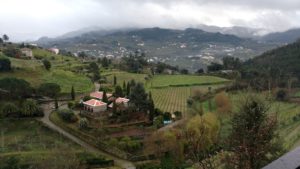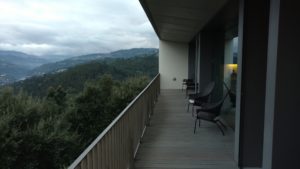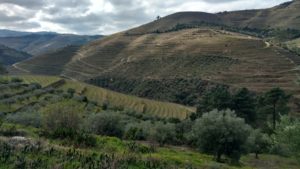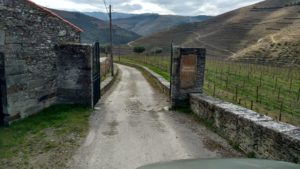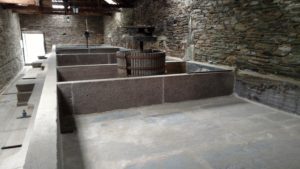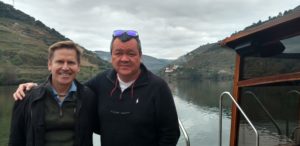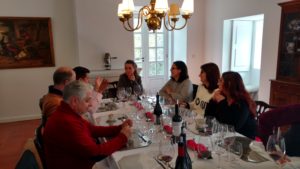The Douro Valley region extends from the city of Porto and the Atlantic Ocean on the west to Portugal’s eastern border with Spain. Within it are three recognized UNESCO World Heritage Sites – one in the historic center of Porto (the Gateway to the Douro Valley) one in the Alto Douro Wine Region, where you will find pre-historic rock art sites in the Coa Valley, and one which contains the Douro Valley vineyards themselves. Within the vineyards, UNESCO recognizes the 2000 years of viticultural work which created a landscape of unreal beauty and reflects the regions technological, cultural, and economic evolution.
The Douro Wine Region is the oldest demarcated wine region in the world. It was demarcated in 1756 to produce Port wine, which is 20 years prior to America’s independence and 100 years before the Bordeaux Premier Cru’s were demarcated by Napoleon. The grape varietals that are grown here include over 200 native to Portugal and many like Tinta Barrocca, Touriga Franca, and Rabigato are direct descendants to the pre-historic vine plants that developed here before man ever arrived in this region. Any combination of these Portuguese varietals can be used to make Douro DOC table and port wines – offering plenty of opportunities for winemakers to be creative.
The terrain is extremely hilly with 45 degree inclines down to the Douro River and necessitated the creation of terraced vineyards that mostly run horizontal to the earth. There are several vertically developed vineyards, and I can only imagine the difficulty of pruning and harvesting the vines while working up and down the hills! As it is, most of the vineyards cannot support any mechanized help, only a burro or a horse are able to augment the manual human labor. The soil consists almost entirely of schist with less than 5% of organic matter. Rain is scarce though out the year, and temperatures can range from 4 degrees C in the winter to a scorching 50 degrees C in the summer. The stress on the vines in this terroir is extreme to say the least.
The vines struggle to stay alive for the first 15-20 years of their planting and, if they make it, their root system goes deep into the schist in search of water as irrigation is forbidden within the Douro region. While the vines are planted close together, there is no competition from the vines to survive, since their root system goes straight down.
My host in the Douro was Tony Smith of new Kindred Vines and Woodberry Wine partner Covela. Tony is a British expat who always dreamed of owning a vineyard, and with his Brazilian business partner Marcelo Lima, he now has three: Quinta da Covela, Quinta da Boa-Vista, and Quinta das Tecedeiras, all within the Douro Valley and situated along the Douro River.
Quinta (which means “country estate”) da Covela is in the Vinho Verde region, between Douro and Minho, and is where Tony now maintains his residence. Covela covers 49 hectares, 14 of which are vineyards and the remaining property includes ancient structures, streams, walking paths, woods, kitchen gardens and orchards of orange and lemon trees. Purchased by Lima and Smith in 2011 the estate has a storied history, and produces award winning wines. In the 1950’s Covela was owned by Renaissance man Manoel de Oliveira, who was one of the most important European film directors of the second half of the 20th Century. Oliveira, who had inherited the estate from his wife’s family after she died, re-imagined Covela and renovated many of the buildings where the winery now operates. In the late ’80s, the estate was sold to businessman Nuno Araújo who invested significantly in the vineyards and helped the wines of Covela gain international acclaim. In 2007, the estate was designated biodynamic and cemented itself among the elites of Portuguese winemaking. Enter Smith and Lima, who purchased Covela in 2011 during the midst of the financial crisis, when banks pulled loans and Araújo lost the property.
They got to work and assembled a great team, including several of the original Covela staff like acclaimed winemaker Rui Cunha and spent two years recovering the vineyards and repairing the buildings. The result is nothing short of amazing. Tony took me on a tour of the estate and it was stunning. The orange trees were loaded with fruit, the landscape was green and lush, and a stream rushed noisily through the property. Dinners are hosted amongst the ruins of the original manor house, Casa de Covela, which dates back to the 1500’s. There are remains of the Chapel St Quiteria, and stone paths that date back to the Roman Empire. Importantly, there are three houses on the property, one of which is Tony’s and one of which is Marcelo’s, and one which serves as a guest house. All of them were designed by the famous contemporary Portuguese architect Jose Paolo dos Santos and have sweeping views of the Douro river valley.
The vineyards at Covela are a thoughtful assemblage of Portuguese and international grape varietals. Local varietals like Avesso and Touriga Nacional are the cornerstones for the Covela blends with Arinto, Chardonnay, Viognier, and Gewürztraminer complementing Avesso and Cabernet Sauvignon, Cabernet Franc, and Merlot blended with Touriga Nacional in the reds.
Dinner my first night was held in the Salon, the second story of a restored building with a roaring fireplace and where I was able to meet Covela export manager Vitor Mendes and Chief Financial Officer Orlando Freitas. There we enjoyed a light pureed vegetable soup, a heavenly rice-less fish stew which included cubes of butternut squash, and a stunning ginger/lemon soufflé. The chef at Covela is truly incredible.
The sensational Covela Rosé, made from Touriga Nacional grapes, was paired with the soup course. This rosé will become a new favorite in the Kindred Vines and Woodberry Wine portfolio, with extraordinary acidity, elegance and light fruit, and a beautiful color. It is a refined gastronomic rosé. The seafood stew was paired with the Covela Reserva Branco (not blanco!), a blend of Avesso, Arinto, Chardonnay, and Viognier and has a beautiful straw color, notes of melon and pear and carries a sophisticated weight to it. Dessert was deliciously paired with the Tecedeiras Tawny port (more on Tecedeiras to follow).
The Covela line is quite large and we look forward to expanding the Covela brand over time throughout the Central United States market. Our initial order with Covela includes the rosé and the Vinho Verde – Avesso, a wine which Tony Smith, when asking wine maker Rui Cunha if there was a style of wine that he always wanted to create but never could, said “yes, a vinho verde made from 100% Avesso”. His idea was a smashing success and sold out its first vintage, and we are thrilled to introduce it to the United States market. The wine has a bright and floral nose with vibrant lemon aromatics, and lemon and peach flavors on the palate. It is a beautiful and sophisticated vinho verde that will be sell out quickly.
Continuing my education of the Douro Valley, Tony scheduled a one hour boat ride on the Douro River the next morning, followed by lunch at Boa-Vista, his stunning and famous sister property.
While on the boat and cruising past the many historic Quintas in the Douro Valley, Tony explained to me the story of Joseph James Forrester, ultimately anointed Barron Forrester by Ferdinand II of Portugal in 1855. In 1831 the young Forrester left England and went to Oporto at the age of 22 to join his Uncle James’ business. Over the next 15 years young Barron Forrester conducted a painstaking survey of the Douro River and in 1848 he created the quintessential geological map of the river from the Spanish frontier to its mouth at Oporto. Barron Forester also published numerous articles on the business of Port wine, and lived in what is now Quinta da Boa-Vista. He drowned at the age of 52 when the boat in which he was in on the Douro was swamped in one of the rapids. He is still remembered as the ‘protector of the Douro.’
While on the cruise, we came upon Tony and Marcelo’s third Douro project – Quinta das Tecedeiras, where they have secured a 40-year lease on the property and create award winning wines and ports which Kindred Vines Import Co and Woodberry Wine will be bringing in to the US market. This includes the Flor das Tecedeiras, Quinta das Tecedeiras Reserva, and the Tecedeiras Tawny Port Reserva. While we didn’t have time to stop, the 67-hectare estate’s terraced vineyards went all the way down to the water’s edge, and rows of Olive trees dominated the remaining landscape. It was extremely picturesque and the wines, which were previously tasted with Tony at the Woodberry Wine warehouse, are fantastic.
After our cruise, we drove to the 80-hectare estate Quinta da BoaVista, which Tony and Marcelo purchased in 2013. All I can say is “wow”! I believe that this vineyard will become the most photographed in the Douro Valley in the years ahead – it is that stunning. The historic stone terraces are reminiscent of Machu Pichu stone architecture and were built by man and beast over hundreds of years. Here is where Barron Forrester once lived, and is where some of the greatest wines in the Douro Valley are now coming. Indeed, Tony and Marcelo have assembled a world class team. Jean Claude Berrouet, who oversaw 44 years of winemaking at Chateau Petrus, along with winemaker Rui Cunha saw their first vintage get the highest scores awarded from Robert Parker for Portuguese table wines: 94 points for the BoaVista Vinha do Oratório and 95 points for the BoaVista Vinha do Ujo. Less than 1000 bottles were made of each and sadly, they are no longer available for sale – but he 2014 vintage will be available soon!
It is obvious that the French-Portuguese collaboration on the wines is clearly working.
After a brief tour of the property, we were joined by some Portuguese retailers and were all fortunate to be led by Tony in a tasting of the three BoaVista wines – the Reserva, Vinha do Oratório, and Vinha do Ujo.
The grape varietals grown at BoaVista include Touriga Nacional, Touriga Franca, Tinta Roriz, Sousão, Tinto Cão, Tinta Barroca and Alicante Bouschet. Besides the three standard bearers we tasted BoaVista will also bottle a monovarietal wine every year.
The BoaVista Reserva is a full-bodied blend with nice acidity and intensity. The wine is youthful and powerful and 5000 bottles were made. The Oratorio, named for the picturesque vineyard from which it comes, is a wine of superb balance and old world charm. Coming from vines planted in the 1930’s, the ripe fruit and concentrated freshness were incredible, and it would be fun to taste this wine again in 10 years. More new world in style, the Vinha do Ujo is silky and authoritarian, with great structure and power, and a long muscular finish.
After the tasting, we took the bottles downstairs to lunch, where the chef from Covela was there to prepare another gourmet feast. We started with a cucumber and fresh greens salad, moved on to roasted chicken with local wild rice, and ended with a lemon custard flambé. The wines continued to evolve over the luncheon, and continued to impress and generate much discussion.
We took a glass out on the veranda to take in the beauty of the Douro River and valley, as well as the magnificent BoaVista terraces, and we were all awe struck. A coffee soon followed, and we then said our goodbyes and drove back to Covela. After some time to stroll the grounds, get refreshed and answer emails, we went to dinner at the famous Six Senses Douro Valley, who is an extremely good Covela client, and had another incredible wine and food pairing. I opted for the potted vegetables for my meal, and I must say it was outstanding.
Tony Smith, Marcelo Lima and the Covela and Boa Vista teams have accomplished an incredible amount in a short period of time. Their commitment to quality and to being good stewards to the historic properties for which they are now caretakers is unwavering. They are terrific hosts and I am grateful to represent their wines and to call them partners and friends. I look forward to a long future together and I know that their wines will be extremely well received in the United States.
Comments are closed

